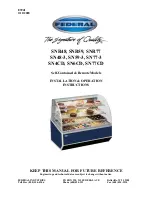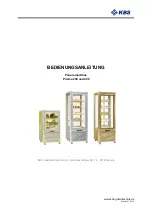
Garmin G950 Pilot’s Guide for the Pilatus PC-6
190-00870-02 Rev. A
292
HAZARD AVOIDANCE
SY
STEM
O
VER
VIEW
FLIGHT
INSTRUMENTS
EIS
AUDIO P
ANEL
& CNS
FLIGHT
MANA
GEMENT
HAZARD
AV
OID
ANCE
AFCS
ADDITIONAL FEA
TURES
APPENDICES
INDEX
RADAR SIGNAL ATTENUATION
The phenomenon of radar signal attenuation affects the operation of weather radar. When the radar signal
is transmitted, it is progressively absorbed and scattered, making the signal weaker. This weakening, or
attenuation, is caused by two primary sources, distance and precipitation.
Attenuation because of distance is due to the fact that the radar energy leaving the antenna is inversely
proportional to the square of the distance. The reflected radar energy from a target 40 miles away that fills
the radar beam is one fourth the energy reflected from an equivalent target 20 miles away. This would appear
to the operator that the storm is gaining intensity as the aircraft gets closer. Internal signal processing within
the radar system compensates for much of this distance attenuation.
Attenuation due to precipitation is not as predictable as distance attenuation. It is also more intense. As the
radar signal passes through moisture, a portion of the radar energy is reflected back to the antenna. However,
much of the energy is absorbed. If precipitation is very heavy, or covers a large area, the signal may not
reach completely through the area of precipitation. The weather radar system cannot distinguish between an
attenuated signal and an area of no precipitation. If the signal has been fully attenuated, the radar displays
a radar shadow. This appears as an end to the precipitation when, in fact, the heavy rain may extend much
further. A cell containing heavy precipitation may block another cell located behind the first, preventing
it from being displayed on the radar. Never fly into these shadowed areas and never assume that all of the
heavy precipitation is being displayed unless another cell or a ground target can be seen beyond the heavy
cell. The WATCH® feature of the weather radar system can help in identifying these shadowed areas. Areas
in question appear as shadowed or gray on the radar display. Proper use of the antenna tilt control can also
help detect radar shadows.
Attenuation can also be due to poor maintenance or degradation of the radome. Even the smallest amount of
wear and scratching, pitting, and pinholes on the radome surface can cause damage and system inefficiency.
RADAR SIGNAL REFLECTIVITY
P
reciPitation
Precipitation or objects more dense than water, such as the surface of the earth or solid structures, are
detected by the weather radar. The weather radar does not detect clouds, thunderstorms, or turbulence
directly. It detects precipitation associated with clouds, thunderstorms, and turbulence. The best radar
signal reflectors are raindrops, wet snow, or wet hail. The larger the raindrop, the better the reflectivity. The
size of the precipitation droplet is the most important factor in radar reflectivity. Because large drops in a
small concentrated area are characteristic of a severe thunderstorm, the radar displays the storm as a strong
return. Ice crystals, dry snow, and dry hail have low levels of reflectivity as shown in the illustration, and
often not displayed by the radar. Additionally, a cloud that contains only small raindrops, such as fog or
drizzle, does not reflect enough radar energy to produce a measurable target return.







































